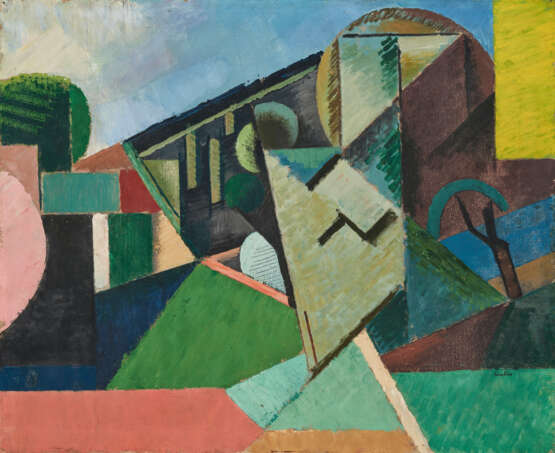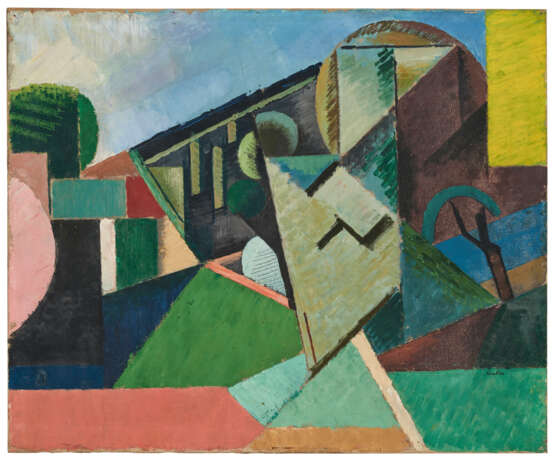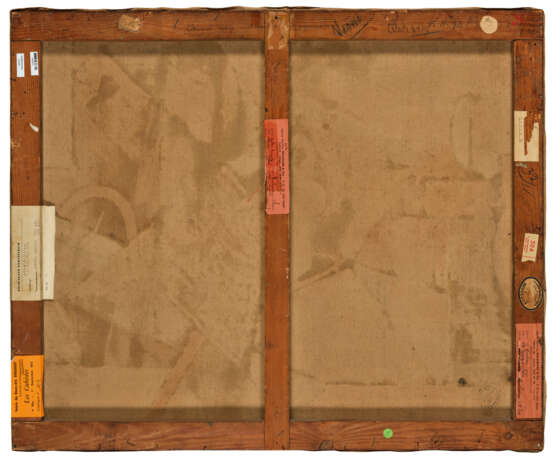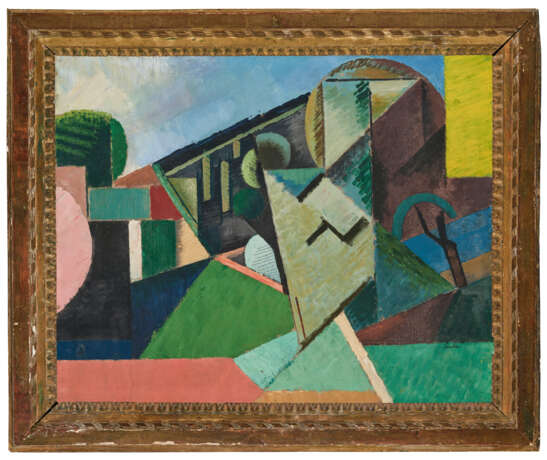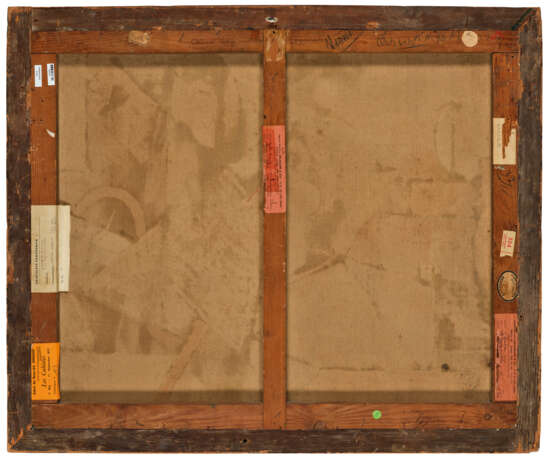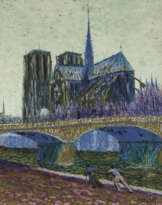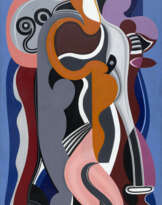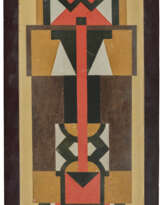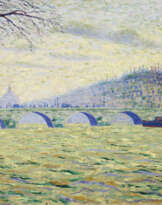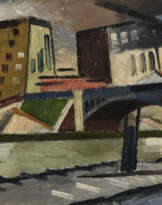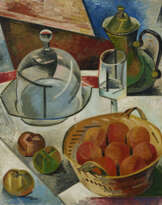ID 1400270
Lot 317 | Auguste Herbin (1882-1960)
Estimate value
€ 150 000 – 250 000
Métairie à Nogarède
signé ‘herbin’ (en bas à droite)
huile sur toile
60 x 73 cm.
Peint en 1913
signed 'herbin' (lower right)
oil on canvas
23 5/8 x 28 ¾ in.
Painted in 1913
Provenance
Galerie L’Effort Moderne (Léonce Rosenberg), Paris.
Galerie Sept, Paris.
Vente, Mes Loudmer, Poulain et Cornette de Saint-Cyr, Paris, 26 novembre 1972, lot 64.
Collection particulière, France (en 1973).
Puis par descendance au propriétaire actuel.
Literature
G. Claisse, Auguste Herbin, Catalogue raisonné de l’œuvre peint, Lausanne et Paris, 1993, p. 332, no. 301 (illustré).
Exhibited
Paris, Galerie Moderne (Clovis Sagot), Exposition Auguste Herbin, mars 1914, p. 3, no. 48.
Cologne, Kölnischer Kunstverein, Autour du cubisme, avril-mai 1964, no. 25 (titré 'Marne à Créteil').
Bordeaux, Galerie des Beaux-Arts et Paris, Musée d’Art Moderne de la ville de Paris, Les Cubistes, mai-novembre 1973, p. 65, no. 105 (titré 'Les Chênes-lièges à Céret').
Rome, Galleria d’Arte Moderna, Auguste Herbin, 1973, no. 49.
Further details
Né en 1882 dans une famille d’ouvriers tisseurs près de la frontière belge, Auguste Herbin débute à 16 ans des études à l’école des Beaux-Arts de Lille en 1900. Très vite, il rejoint Paris et peint dans le style postimpressionniste, courant à l’époque. Il expose au Salon des indépendants en 1906 puis rencontre Picasso et Braque trois ans plus tard. Dans les années 1910, Herbin a adopté le style post-cubisme comme beaucoup de ses pairs influencés par Braque et Picasso dont il visite les ateliers. A l’été 1913, Herbin sillonne le sud-ouest de la France en vue de rejoindre Céret, non loin de Collioure et de la frontière espagnole. Sur son chemin, il s’arrête à La Salvetat-Belmontet en Occitanie où il exécute cette toile représentant la Métairie de Nogarède.
La composition cubiste par essence est découpée rigoureusement en un certain nombre de variations géométriques et d’aplats de couleurs. La nature et le paysage sont représentés d’un point de vue unique. Si l’on distingue encore des repères architecturaux comme les arches d’un pont de chemin de fer ou des montagnes environnantes dans ses toiles telles que Paysage de Céret aujourd’hui conservé au musée d’art moderne de Céret, aucun élément dans la présente œuvre ne serait traduire clairement la présence de la métairie de Nogarède. Le hameau, supposément présent dans la région depuis le XVIIe siècle, se fond dans une superposition de formes géométriques diverses où la couleur est puissante et vive. Herbin conserve cet attachement fort à la couleur pure tout au long de sa carrière et théorise son emploi et son langage en 1949 lorsqu’il publie L’Art non-figuratif, non-objectif dans lequel il affirme : « La couleur pure est belle en elle-même et par elle-même » (cité in Auguste Herbin, L’Art non-figuratif, non-objectif, p. 94.)
Métairie à Nogarède annonce le cubisme de synthèse adoptée par Auguste Herbin en 1913; un cubisme où les parallélogrammes, les ellipses, les rectangles, les carrées et les losanges viennent s’ajouter aux cercles et triangles. La toile se transforme en une mosaïque ou les formes et la couleur priment. Cette production pleine de créativité et de joie atteint son apogée à Céret où le peintre exécute une vingtaine de paysages remarquables en un laps de temps très court.
Au printemps 1914, la galerie Moderne de Clovis Sagot, l’un des premiers marchands de Picasso, organise une rétrospective dédiée à l’œuvre d’Auguste Herbin, regroupant cinquante-huit œuvres peintes entre 1907 et 1913 dont Métairie à Nogarède. Le critique d’art allemand Wilhem Uhde, collectionneur de Braque et Picasso, soutient Herbin depuis le début de sa carrière et écrit notamment dans la préface d’une exposition dédiée à Herbin à la galerie Clovis Sagot en mai-juin 1908 : « Ainsi nous trouvons dans les peintures de Herbin une jeunesse passionnée, une joie de vivre forte et victorieuse et des couleurs flamboyantes et distinguées dont la distribution parle d’une âme cultivée et productive. Il y a une infinie douceur, une harmonie superbe dans l’arrangement de ces taches fortes et simples. » (cité in Galerie Clovis Sagot, éd., Exposition des Peintures & aquarelles de Auguste Herbin, mai-juin 1908).
Born into a family of weavers near the Belgian border in 1882, Auguste Herbin began studying at the School of Fine Arts of Lille in 1900 at the age of 16. He moved to Paris shortly after, where he adhered to the Post-Impressionist style, that was the contemporary art trend back then, in his own paintings. He exhibited at the Salon des Indépendants in 1906 and met Picasso and Braque three years later. In the 1910s, Herbin followed the Post-Cubism style like many of his peers, influenced by Braque and Picasso, whose studios he visited. In the summer of 1913, Herbin explored South-West France as he travelled to Céret, a picturesque town close toCollioure and the Spanish border. On his way, he stopped at La Salvetat-Belmontet in South-West France , where he realised this painting depicting the Métairie de Nogarède.
The composition is Cubist in essence as it is rigorously divided into a certain number of geometric shapes and flat areas of colour. Nature and the landscape are represented from a single point of view.Architectural landmarks such as the railway bridge’s arches, or the surrounding mountains are still present in his paintings such as Paysage de Céret, now in the Céret Museum of Modern Art. However in this instance, there is nothing in the present work that clearly referes to the Nogarède farmhouse. This hamlet, supposedly exists in the region since the seventeenth century, and blends into different layers of geometric shapes, wherecolour is powerful and vibrant. Herbin maintained this strong attachment to colour throughout his career, theorizing its use and language in 1949 when he published L'Art non-figuratif, non-objectif, in which he asserted: ‘Pure colour is beautiful in and of itself’ (cité in Auguste Herbin, L’Art non-figuratif, non-objectif, p. 94.).
Métairie à Nogarède epitomizes the synthetic Cubism adopted by Auguste Herbin in 1913, a Cubism in which a wide range of geometric shapes were added to circles and triangles. The canvas is transformed into a mosaic where shapes and colours take centre stage. This type of production, full of creativity and joy, reached its climax in Céret, where the painter produced around twenty remarkable landscapes in a very short space of time.
In the spring of 1914, the Galerie Moderne run by Clovis Sagot, one of Picasso's first dealers, organized a retrospective dedicated to Auguste Herbin, compiling fifty-eight works painted between 1907 and 1913, including Métairie à Nogarède. The German art critic Wilhem Uhde, a collector of Braque and Picasso, supported Herbin from the start of his career, writing in the preface to another exhibition dedicated to Herbin at the Clovis Sagot gallery in May-June 1908: "Thus we find in Herbin's paintings a passionate youth, a strong and victorious joie de vivre and flamboyant and distinguished colours whose distribution speaks of a cultivated and productive soul. There is an infinite gentleness, a superb harmony in the arrangement of these strong and simple spots." (cité in Galerie Clovis Sagot, éd., Exposition des Peintures & aquarelles de Auguste Herbin, mai-juin 1908).
| Artist: | Auguste Herbin (1882 - 1960) |
|---|---|
| Applied technique: | Oil on canvas |
| Auction house category: | Paintings, Watercolors, Drawings, Paintings |
| Artist: | Auguste Herbin (1882 - 1960) |
|---|---|
| Applied technique: | Oil on canvas |
| Auction house category: | Paintings, Watercolors, Drawings, Paintings |
| Address of auction |
CHRISTIE'S 8 King Street, St. James's SW1Y 6QT London United Kingdom | |
|---|---|---|
| Preview |
| |
| Phone | +44 (0)20 7839 9060 | |
| Buyer Premium | see on Website | |
| Conditions of purchase | Conditions of purchase |
